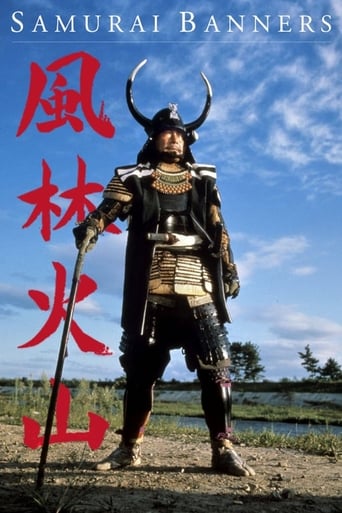Patrick McCoy
Samurai Banners (1969) is Hiroshi Inagaki's, know for The Samurai: Musashi Miyamoto trilogy, crowning achievement-a nearly three hour historically based epic starring Toshiro Mifune as a ronin determined to achieve greatness in his new clan by uniting Japan under one ruler. The story is based on a novel adapted by Shinobu Hashimoto (Rashomon and Seven Samurai) and takes place in the Sengoku warring period 1500-1600. At the time it was the most expensive Japanese film produced with several massive fight scenes that must have been expensive to stage. It immediately calls to mind Akira Kurosawa's two late samurai epic masterpieces Kagemusha and Ran. I wonder why he wasn't involved in the project that was made with his former leading man and the script writer of his greatest triumphs. Nonetheless, Inagaki with cinematographer Kazuo Yamada has created a stylish, colorful, and dynamic film.
massaster760
After watching Samurai Banners, I was struck with one piece of dialog which sums up the film quite nicely, "In this age of war, survival requires complex conspiracies, secret dealings, and assassinations. They're inevitable." These two lines help describe the atmosphere of 16th century Japan, in which Samurai Banners is set. A Japan divided by warring factions and lords, where treachery and war are the only way of life.Yamamoto Kansuke (Mifune) is a ronin, who through chance of fate finds himself protecting Lord Takeda's vassal from another Ronin (in a very bloody exchange). Kansuke then moves to the province of Kai, where Lord Takeda awards him a troop of 100 soldiers. Once established Kansuke moves his way up to be Lord Takeda's top military adviser. With Kansuke's help the province of Kai stretches it's grasp to the other provinces through a series of, "complex conspiracies, secret dealings, and assassinations." Samurai Banners is an intricately researched samurai epic. The outfits are incredible, especially Mifune's fearsome black samurai armor which boasts the most incredible helmet I've ever seen. The outfits of the Red Guard are also very impressive and help add to the allure of the film. The set's also match the intensity of the outfits and this film highly succeeds in painting an accurate picture of 16th century Japan.Mifune is as bad-ass as ever (Of course!) but this time around he sports (besides the crazy armor) a ugly scar, a noticeable limp, and a awesome moustache. In Samurai Banners he plays the "terrifying" Kansuke, a man who is both feared and revered by his troops. In typical Mifune fashion, his one soft spot is for a woman named Pricess Yu. Both the Lord's concubine and an unrequited love interest for Kansuke.The film itself stays true to the tradition of 60's chambara; a mix of action, romance, war tactics, and character development, which together, helps round out another solid entry for both Mifune and Director Inagaki Hiroshi. The film substitutes most of the battles for the strategies and goings on of the Lord's and his advisor's, although the film has its share of action don't go into this expecting an action packed Chambara flick.Bottom Line- Good historical war epic with a focus on the people involved more-so than the actual battles. Mifune is a bad as ever!
krilljp
Lots of attention to historical detail, like the horned kabuto worn by Yamamoto Kansuke. Climactic battle (4th Kawanakajima)between the Takeda and Uesugi well worth seeing. Story told from the viewpoints of Kansuke and his overlord, Takeda Shingen. I liked this a lot more than the 1990 "Heaven and Hell," which retold the story of the rivalry between Takeda Shingen and Uesugi Kenshin, but from Kenshin's viewpoint. For example, the later movie seemed less accurate and more artsy (each side's soldiers all wore the same standard-color sashimono)in its depiction of the same battle.
weber
One of the best samurai epics. "Furinkazan" tells the story of the 16th century warlord Takeda Shingen and his loyal general Yamamoto Kansuke (Mifune Toshiro) embedded in the story of the Takeda clan's rise to power. Outstanding sets, costumes and Sato Masaru's rich soundtrack make the drama highly enjoyable.


